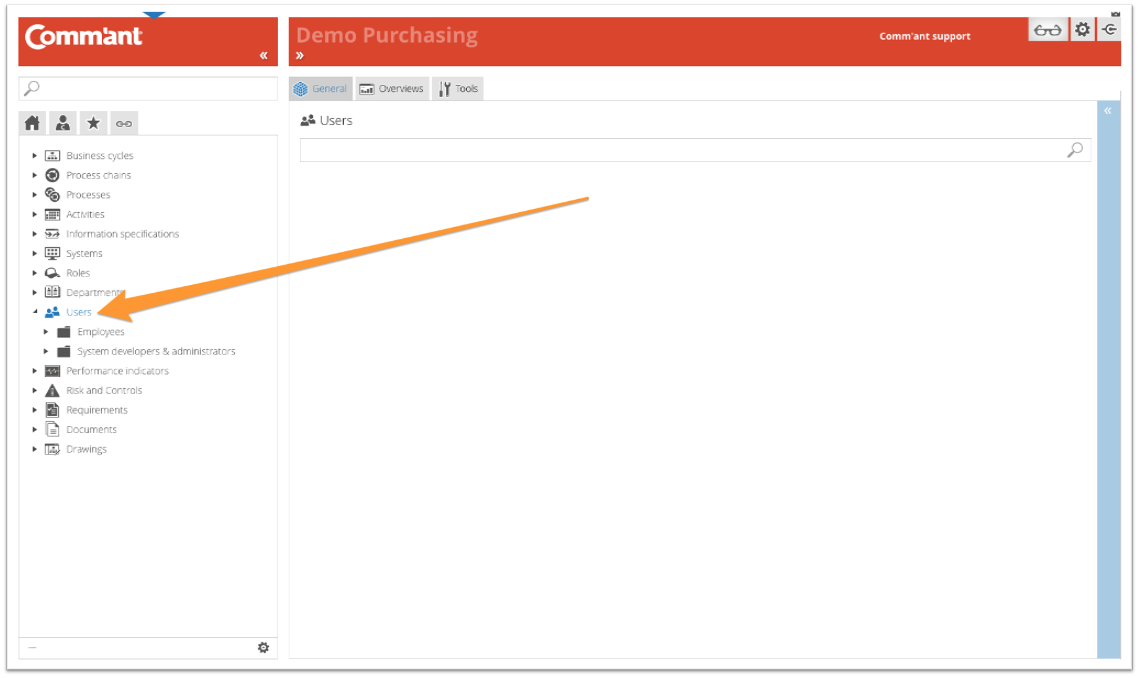Users
All users of the Comm’ant system are included under the Users object. The Users object is necessary to grant access to the System and to register certain characteristics. This object generally refers to one person, but may also be used anonymously. The user may include a photo and a personal profile or description that refers to education, experience, qualities, and employability
The user may be included in a particular group. These groups usually refer to the type of rights the user has in the system.
User rights
A user can have different types of rights in the system:
- User. A User can consult the Comm’ant system and see how the information is organized.
- Editor. This is an intermediate type where an employee can View and Edit (as in updating specific information). An employee with these rights can switch between viewing
 and editing
and editing  using the button in the Application bar.
using the button in the Application bar. - Developer. An employee with these rights can View, Update, Modify and Delete information. An employee with these rights can switch between viewing
 and modifying
and modifying  using the button in the Application bar.
using the button in the Application bar. - Document manager. An employee with these rights has the option to manage (create and modify) the Documents object type.
- Application managers are employees who are allowed to create other users and adjust various system settings.
Users > Organization function > Role > Process
A user is connected to one or more organizational functions. The user or the person in question is considered responsible for the performance of the function and all roles in the Process where this function is stated.
The organizational function is listed at many roles in the Process, especially the input and output. The user is thus linked to his tasks, responsibilities, and authorities via the organizational function.
For instance:
- Peter Smit is sales manager >
- The sales manager is the process manager of the sales process >
- The sales manager is the functional manager of the sales employee.
Folder structure/groups
The folder structure can be organized as you see fit, but in many cases, it is used to indicate which rights a user has with regard to the Comm’ant system (user, editor, developer, etc.).
When you click on a folder or Users group, the tree structure opens and at the same time, Comm’ant shows the contents of the folder in question on the Main screen. You select the contents of the folder by either clicking on a User in the tree structure or in the Main screen. Both in the tree structure and in the Main screen you can navigate further down to the lowest level.
Selected User
After selecting, the Main screen shows more detailed information about the User.
Note:
These fields are only shown when they contain information.
Name username
The name of the user who is displayed in the Application bar after logging in.
Description
If remarks are included with the user, they will be displayed.
Email address
The e-mail address of the relevant user is displayed here.
Boxes
At the bottom are the boxes that show which attributes are linked to the Users object. These boxes show the attribute title in the top bar with the specific attributes below. These blue boxes represent the attributes that are directly linked to the User.
By clicking once on the top bar, all boxes are minimized or maximized. Clicking the same spot again has the opposite effect.
Connections of a selected User
Just above the Navigation menu is the button that opens the Links-tab. This button shows the Links menu instead of the Navigation menu; an overview of the direct and indirect links of a selected User with other objects:
| Links to |
Links how |
| Organization | directly |
| Documents | directly |
Note: The Links button ![]() has two options: Linked objects and Dynamic links.
has two options: Linked objects and Dynamic links.
- With ‘Dynamic links menu’
 enabled, the links menu will alter every time a different element is displayed on the Main screen.
enabled, the links menu will alter every time a different element is displayed on the Main screen. - With ‘Linked objects menu’
 enabled, the links menu will remain the same regardless of what is displayed on the Main screen
enabled, the links menu will remain the same regardless of what is displayed on the Main screen
The default setting of this button is the ‘Linked objects menu’, but hovering over the button enables you to select ‘Dynamic links menu’ as well. With ‘Dynamic links menu’ enabled, the icon gets an asterisk for recognition: ![]() .
.


